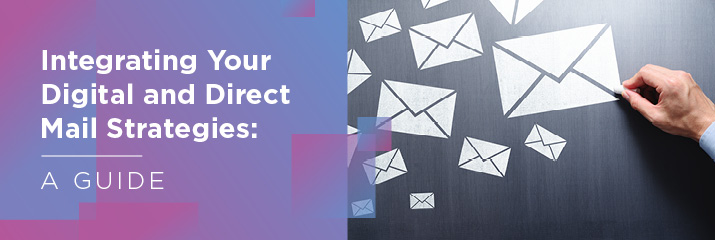Creating a marketing campaign might sound simple enough, but implementing a strategy with a multichannel approach is easier said than done. Integrating your direct mail and digital marketing outreach can truly maximize your fundraising efforts and help you better engage with the individuals who fund your mission.
If you want to engage in direct outreach, direct mail can be a great option. As Pursuant’s direct mail guide explains, donors are more likely to engage with direct mail than email marketing. Because direct mail appeals are the backbone of communication and fundraising for many nonprofits, integrating your direct mail approach with your preexisting digital marketing strategy is a great way to meet your donors across all of the platforms they engage with.
Here are three outcomes you can achieve by integrating your digital and direct mail strategies:
- Build long-term donor relationships
- Leverage your organization’s data
- Introduce donors to new communication channels
Direct mail is a non-invasive way to call on your donors and prospects to support your nonprofit and build your brand. With this strategy in your marketing toolkit, your organization can easily interact with your donors, build long-term relationships, educate them about your organization, and invite them to participate.
1. Build long-term donor relationships
Direct mail provides a 1-1 marketing touch that gives you the opportunity to increase the personalization of your appeals and build stronger relationships with donors. Providing a personalized experience involves leveraging donor data to learn more about how and why they donate. With donor segmentation, you can create custom groups of donors based on shared characteristics to build authentic relationships and increase overall donor retention.
Once you segment donors by their preferences and key characteristics, try these strategies to make them feel like a valuable member of your team:
- Relate the donation to the mission. When writing your direct mail or digital appeals, make sure to center your case for support. If your case for support is clear, your donors will understand why you need assistance and how they can participate. It also allows your donors to feel a deeper connection to the overall cause, your organization’s vision, and how their support helps you reach your goals.
- Attach each donation with its direct impact. Explain how the gifts your donors contribute are being used to bring their impact full circle. When you share the significance of each donation and what it accomplished, you are building a sense of connection between your organization and the donor. For example, you might share an impact story with your donor explaining that their gift purchased 20 cans of food for a family in need.
- Express gratitude. Practicing donor stewardship is just as important as asking for gifts. After all, showing your appreciation is one of the easiest ways to keep them engaged. When supporters receive a thank-you note or letter, they’ll feel acknowledged, be reminded of the donation they made, and feel empowered to continue supporting your organization.
Customized messages that appeal to your donors’ unique reasons to give add a personal touch to your campaigns. Remember to regularly update donor data in your CRM platform so you can continue to personalize your communications and tap into the motivation for your donors’ support.
2. Leverage your organization’s data
The next step to integrating direct mail into your overall fundraising campaign is to utilize the data you collect to your advantage. The data in your nonprofit database should support your fundraising strategy, helping you find the most effective ways to reach your supporters.
You can use the following pieces of information to tailor your communications to donors:
- Communication preferences. Reach out to donors on the platform they are most familiar and comfortable with. Make sure to deliver important messages (like reminding them to register for an event before an encroaching deadline) through their preferred channel. From there, you can use this “primary” channel to direct supporters to channels they might not use as often, creating an integrated communication strategy with multiple donor touchpoints. This gives donors more opportunities to interact with your nonprofit and increase their involvement.
- Past involvement with your organization. Make note of the size and frequency of gifts your donors made in the past, as well as any volunteer opportunities they participated in. You can use this information to tailor the amount you request, acknowledge past involvement, and invite them to events and opportunities they would likely be interested in. You can also use data about your donors’ involvement with other similar organizations to gauge the donor’s affinity for your cause.
- Reference demographic data. Demographic data like age, gender, ethnicity, or marital status can give you hints about how to approach donors. For example, you might choose a more formal greeting for donors from older generations and reach out to them primarily through direct mail and telephone calls. On the other hand, you can also reference donors’ income to better understand their giving capacity, make realistic solicitations, and smoothly suggest upgrades.
Donor data gives your organization the information it needs to tailor messages to supporters no matter which platform you reach them on. Showing that you care about and cater to their needs, interests, and expectations is a core component of building trust with your supporter base.
3. Introduce donors to new communication channels
To integrate your marketing campaigns, you’ll sometimes need to expose donors to new communication channels they aren’t familiar with. This could look like asking donors who receive direct mail marketing to sign up for your virtual newsletter to get more frequent updates or an advocacy action.
As you work to expand your reach across multiple platforms, consider using the following strategies:
- Keep branding consistent. If a donor only receives messages from your organization through direct mail, they may not be accustomed to communicating with you on different channels like social media. To create a seamless constituent experience (even on unfamiliar platforms), make sure to keep the branded elements of your messages the same. Using your organization’s specific brand colors, fonts, voice, logo, and photos makes your messages recognizable and memorable to donors.
- Include URLs and QR codes on direct mail. To drive more donors to your digital communication channels, make finding and engaging with online resources convenient. Include scannable QR codes and short, easy-to-enter URLs on pieces of direct mail. Keep in mind that you can track website traffic that comes from these sources to measure how many donors are visiting your website because of direct mail outreach.
- Add ways to sign up for direct mail online. Make it easy for online donors to register for direct mail communications, like your newsletter and other special communications. Consider adding links to a sign-up form on your organization’s website and social media pages. To spread the word to more of your donors, add a call-to-action to an impact story in your email marketing messages inviting donors to sign up to receive valuable information through direct mail.
The more channels your donors use and engage with your organization, the better. Because it can take numerous touchpoints and interactions with supporters before they take action, reaching out to them across a variety of platforms helps you build connections more quickly to yield more successful fundraising results.
Integrating your digital and direct mail marketing campaigns gives your donors more opportunities to engage with and support your organization. Your organization can take advantage of the benefits of direct mail, like its tangibility and trustworthiness, to spread awareness of your digital campaigns with URLs and QR codes to online resources. By intentionally integrating your existing marketing strategies, you can effectively target loyal supporters, appeal to them with personal messages, and introduce them to additional communication channels to build your brand and inspire greater generosity.
About the Author: Executive Vice President, Client Strategy of Pursuant

Jennifer Bielat serves as Executive Vice President, Client Strategy of Pursuant, a fundraising and marketing agency, exclusively serving the nonprofit sector. With more than two decades of experience, Jennifer brings intimate knowledge and understanding of nonprofit management, integrated marketing and communications strategy, comprehensive direct response strategy and execution, digital marketing and fundraising, and nonprofit leadership.

